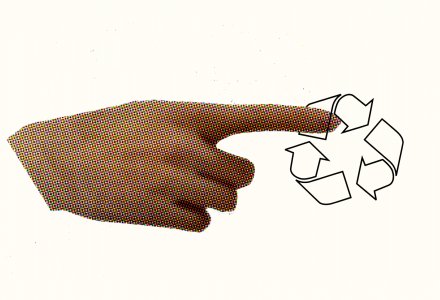Smart Key: Is polyester recycling a sustainable solution? The - Fabrics - Première Vision Paris - Denim Première Vision - Première Vision New York
The overwhelming popularity of recycled polyester would suggest that it’s a kind of miracle solution for fashion and the environment. And although it is a real solution, it’s not as simple as all that, and it’s certainly not a license to mass-produce new polyester for secondary recycling. The recycling process is itself energy-intensive, production channels continue to lack structure and the origin of the transformed material remains difficult to trace. We think it’s important to add here that the energy performance of recycled polyester is still lower than that of natural materials and it is a good idea to remain wary, both in terms of its use and brand message.
The problematic omnipresence of PET
Polyethylene terephthalate, the scientific name for PET, is a plastic, and therefore made from petrochemicals. When it comes in the form of a textile fiber, PET is called polyester, and can be used to manufacture clothing. The majority of PET plastic produced is marketed as polyester [1].

It is estimated that 60% of the virgin PET made across the globe is used to make clothing. The use of polyester is widespread throughout the fashion industry, and over half of fashion products contain polyester, particularly sportswear, footwear and waterproof outerwear. Most people are well familiar with polyester’s negative impact on the environment. Research conducted jointly in 2019 by the Institut Français de la Mode and Première Vision demonstrated that, in Western countries, consumers rank polyester at the top of the list of materials perceived as least eco-friendly, and are expecting brands to introduce change [1].
Several brands (H&M, Timberland, Nike, Esprit, Volcom), alongside the Textile Exchange association, had already committed in 2017 to using at least 25% recycled polyester by 2020 [2]. Using recycled material has an undeniable ecological interest – it takes 50% less energy to make, it avoids producing oceanic waste or landfill and the extraction of non-renewable resources. However, it’s a bit dangerous to present recycled polyester as a miracle solution.
Read also: Smart Key: International sustainability labels to know
The limits of recycled polyester
To start, whether recycled or not, polyester generates plastic microparticles during each wash, microparticles which are released in the wastewater and then into the oceans. Secondly, polyester can’t be infinitely recycled because recycling causes it to lose strength and quality. As of now, it is still quite complex to design a recycled polyester product without the addition of virgin material.
The recycling process is itself energy-intensive, due to the process of dismantling the components of a garment or a shoe, which is made even more complicated by the fact that their are numerous components (often several textiles or even blends, non-dissociable finishings), the use of chemicals for depolymerization, etc. Some companies, such as the TBS brand, are looking to bypass these issues, with for example ReSource, the first sneaker that can be shredded and recycled without requiring dismantling [4].
Read also: Smart Key: Recycling – can the fashion sector become self-sufficient in resources?
It’s still impossible to trace the origin of recycled polyester. Our recycled polyester garments are mostly made from used packaging, and their origins are unknown. Citeo, the French organization in charge of organizing and developing packaging recycling, says 15 PET bottles must be recycled to make a polyester sweater [3]. To ensure their production volumes in recycled polyester, brands thus require access to a large and stable pool of raw materials. They must therefore necessarily use recycled PET from the selective sorting of private individuals. It is important to be wary of brands making assurances to the consumer of the “recycled from ocean waste” nature of a material or finished product.

On the consumer side, it is possible to refer to certain labels such as GRS (Global Recycle Standard), OEKO-TEX STeP and Bluesign, which guarantee that a given recycled polyester has been produced as cleanly as possible, limiting the presence of solvents and other chemicals in its manufacturing.
The various sub-sectors continue to fall short of ambitions, because structuring these recycling activities amounts to creating a second parallel industry. Raw material deposits are multi-site (pre-consumer as at Mud Jeans, and/or post-consumer as at Circle or Shak & Kaï), and the processes of material sorting, defibration, possible depolymerization and then polymerization into a textile fiber require a dedicated industrial park, assisted by substantial financing.
From a strictly environmental point of view, recycled polyester is more sustainable than virgin polyester, yet still less efficient than most natural materials. To date, it seems best to avoid it and, when it is necessary for a garment’s technical performance, to unhesitatingly prefer recycled polyester, and inform consumers in a transparent way about its origins, the decision to choose the material and the best way to care for it in a sustainable way.
Read also: Smart Key: How to combine performance fabrics and eco-responsibility in sports?
Sources :

Article realized in partnership with The Good Goods, the first French-speaking platform dedicated to eco-responsible fashion
Find out more:
→ Interview to Victoire Satto, the co-founder of the Good Goods
→ Replay of the Digital Talk “Regenerative Fashion, Let’s Tackle Climate Change Beyond Sustainability”
With Victoire Satto – Co-founder & EIC, Host of the podcast ON(WARD) FASHION, The Good Goods, Arizona Muse – Activist, Sustainability Consultant, Model, Nina Marenzi – Founder & Director, The Sustainable Angle & Future Fabrics Expo, Elisabetta Baronio – CSR & Sustainability Manager, Timberland EMEA.
